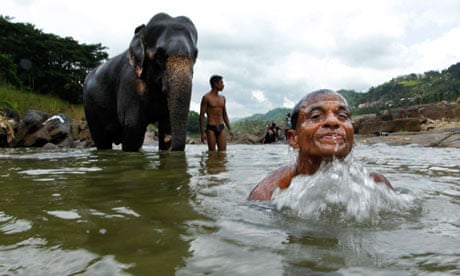Sri Lanka will begin its first census of wild elephants, despite protests from conservationists that the operation is aimed predominantly at finding the healthiest beasts to use in temples, for tourism and for industrial labour.
Conservation groups initially planned to deploy off-road vehicles and provide around 200 volunteers to help with the count, but have now pulled out after local media quoted the wildlife minister SM Chandrasena saying the strongest young elephants would be given to temples.
Sri Lanka traditionally uses tamed elephants for cultural pageants at Buddhist and Hindu temples, domestic transportation, heavy work and within the tourism industry, which is booming in the country after the end of a 30-year civil war in 2009. Wealthy landowners have also traditionally kept elephants as status symbols.
"This [census] is actually a smokescreen to capture wild elephants when they are young and basically take them for domestication," said Rukshan Jayawardene, chairman of Wildlife Conservation Forum.
Jayawardene said one concern was that elephants "will end up in private residences working long hours".
"Breeding males are already in danger of dying out because of the various threats they face on a daily basis," he added. "The young tuskers that one day might grow up to be breeding males are going to be in temples or homes and they will be worked. On humanitarian grounds it is wrong and as a predominantly Buddhist country this is indefensible."
The minister could not be reached for a comment. However, the director general of the country's department of conservation, HD Rathnayake, told the Reuters news agency the operation would go ahead despite the boycott.
During the decades of civil war much of the shrub and jungle in the northern part of the island nation, dominated by the Tamil minority, lay outside government authority. As a result the new census would be the first to cover the entire country for almost 100 years.
More than a thousand soldiers would undertake the count in the north and east, Rathnayake said.
Naturalists estimate Sri Lanka has between 5,000 and 7,000 elephants, only a third as many as at the time of the last full count a century ago.
So far this year conflicts between the animals and humans have claimed the lives of 23 people and 149 wild elephants, while 89 people and 228 elephants died in similar circumstances in 2010, according to government figures. Most elephants are killed by farmers protecting their crops.
Elephants elsewhere in the region face similar problems. As in Sri Lanka, in India a booming population and economic growth have placed the historic grazing lands of elephants under huge pressure. To avoid exhausting fodder in one area, the herds migrate. Their movement brings new dangers with dozens dying on railway lines or caught in live electric cables.
Other hazards include homemade alcohol. Late last year elephants in eastern India got drunk on local hooch, killed three people and destroyed 60 homes in a four-day rampage. The elephants had been attracted to piles of barrels of a fermented rice-based drink stockpiled before a village festival.
Such incidents are increasingly common, experts say, as the animals' natural habitat grows increasingly rare.
"These herds are effectively semi-urbanised," Dr Amirtharaj Williams, Asian rhino and elephant programme co-ordinator for the World Wildlife Fund told the Guardian after last year's rampage.
"There are elephants who are getting a taste for food that humans prepare because it is tastier, stronger-smelling and often more nutritious, and that includes rice or molasses-based drinks. Some go looking for it."
Around 400 people are killed each year by elephants in India and nearly a million hectares of farmland are damaged. Around 100 elephants are killed by villagers every year. Latest estimates put India's elephant population at around 21,000 – the largest in Asia.
